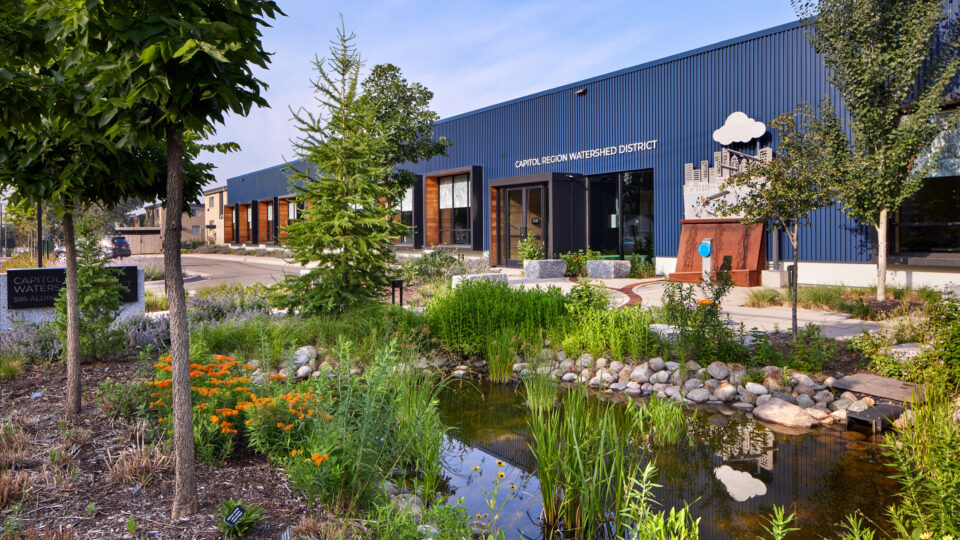We incorporated numerous clean water features to collect rainwater and allow it to soak into the ground. Not a drop of rain leaves our site!
When it rains or snow melts in a city, water flows over hard surfaces like roads, sidewalks, and roofs and into the storm sewer system. Without treatment, the system quickly carries water to nearby lakes and the Mississippi River. Anything on the street, like trash, salt, or leaves, ends up in our waterways.
We help build projects to slow down and soak up water before it reaches storm drains. There are rain gardens, a rainwater reuse system, permeable pavement, tree trenches, and underground infiltration pipes to capture and clean every drop of water that lands on our property.
Rain Gardens
Rain gardens around our site collect water from our garage roof, parking lots and sidewalks. They soak up and clean rainwater to help protect our lakes and the Mississippi River. The roots of native plants and soil microbes help break down pollutants in the water while it seeps deeper into the ground. In the gardens on the west side of our building, any extra water overflows to the underground infiltration pipes.
Native plants provide a habitat for pollinators like birds, bees, butterflies, and other wildlife. We’ve even spotted the endangered rusty-patched bumble bees in our gardens. We have over 43 species of native plants across our site.
Tree Trenches
The tree trenches around our site help protect the Mississippi River by cleaning polluted rainwater that would otherwise flow directly to the river without treatment.
Rainwater from the street flows to a trench planted with trees and filled with soil and rocks underground. The trees sink their roots into the rocks where the water is stored. Excess water seeps deeper into the ground and is filtered by the layers of rock and soil. The leaves of the tree canopy help intercept rainwater before it reaches the ground. You can find more tree trenches along the Green Line on University Avenue and at Allianz Field.
Trees provide food and habitat for wildlife, improve air quality and keep our neighborhood cooler in the summer. We added over 40 native trees like swamp white oak, tamarack, and blue beech around our site.
Permeable Pavers
The bricks in our east parking lot are called permeable pavers because rainwater flows through the gaps and soaks into the ground below. Permeable pavers prevent rainwater from carrying pollution like trash, salt, and leaves to the Mississippi River.
Cistern
Rainwater is collected from the roof, stored in a 3,000-gallon cistern inside the lobby, filtered, and used around the site for flushing toilets, supplying the Watershed exhibit and pond, and nourishing the gardens and trees.
The cistern is connected to weather forecasting and empties into the rain gardens behind our building before storms arrive. This allows us to collect and reuse more rainwater while nourishing our gardens.
Underground Infiltration
Four-foot diameter pipes with thousands of holes are hidden below the pavement in the southwest corner of our site. They can collect 75,000 gallons of rainwater and snowmelt from the parking lots and extra water from the cistern and rain gardens. Pollutants in the water and soil are broken down as the water slowly seeps deeper underground.
Pocket Park
When we envisioned the grounds, we aimed to create a beautiful green space to benefit the community. Our pocket park is a neighborhood gem, featuring a tranquil pond and a small meandering stream channel fed by rainwater from the cistern. In addition, our interactive Watershed exhibit is popular with children, as is the Little Free Library, along with the game cards for the Water Wildlife Exploration Game for the sidewalk stamps around our building. The boulevards are a delightful mix of native plants and wildflowers, which provide essential food and habitat for pollinators like bees and butterflies. People of all ages, including neighbors, staff, and visitors, come to enjoy our pocket park.






